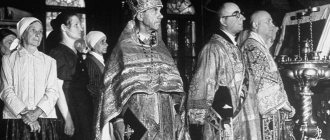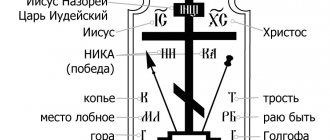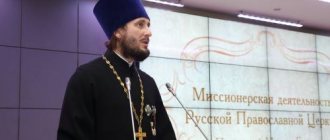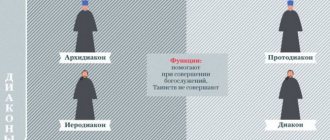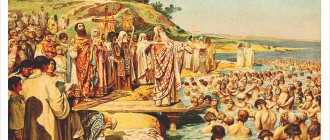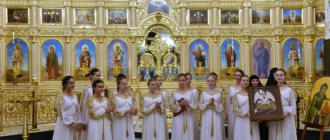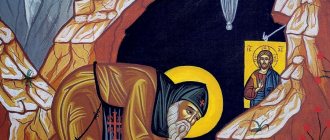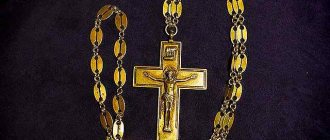The priestly cross in modern practice of the Russian Orthodox Church
The first thing that needs to be said is that the priest’s pectoral cross, so well known in Russia, is practically not used in churches of the Greek tradition in the East. In our country, it became an attribute of a priest not so long ago - at the end of the 19th and beginning of the 20th centuries. Before this, priests did not wear a pectoral cross. And if they were worn, then only a few and for a special occasion.
Today, every priest is given this item immediately upon ordination, as part of the obligatory vestments and a sign of distinction from other representatives of the hierarchy. During divine services, clergy wear it over special vestments, and in ordinary times - over their cassock or cassock. There are several types of pectoral crosses: silver, gold and with decorations. But this will be discussed below.
Epiphany Cathedral in Yelokhov
On the days of the celebration of the Exaltation of the Holy Cross, I would like to remind you of an unusual Russian tradition that does not exist in other countries - the wearing of a pectoral cross by priests. Not only parishioners, but also some clergy ask about this story.
There is a legend that once Emperor Paul I visited the monastery.
Having met a monk, he wanted to take his blessing. But he politely replied that he was not a priest. And he has no right of blessing.
The emperor approached another monk he met, but he turned out to be a hierodeacon and was also unable to bless. The surprised Emperor asked the question: how to distinguish a priest? And then the idea came to him of introducing the wearing of a pectoral cross by priests.
Whether this was so is difficult to verify. But there is written evidence that it was during the reign of Paul I that this custom was introduced. The decree of Emperor Paul I to the Holy Synod of December 18, 1797 read:
– And so that priests can receive special honors for excellent services, we determine in favor of the white priesthood: firstly, receiving a cross to wear on a chain around the neck.
Secondly, the use of purple velvet kamilavka or skufia. And finally, thirdly, for the noblest of them, the miter, which is used by archimandrites. With this, however, that these excellent honors will not be given or permitted except by our will or approval.
The Emperor directed the Synod to choose the form of the inscription on the cross. The text was approved: To the presbyter, who gives the image of the faithful word and life. On the reverse side of the cross was the monogram of Emperor Paul I and the date. Established 1797, December 18.
On the front side there was an image of the Crucifixion. The cross was four-pointed on a chain. And it was made of silver with gilding. The design of the cross remained unchanged until the 1917 revolution.
Soon after its establishment, it acquired the name: Pectoral Cross issued by the Holy Synod. Although in fact, until 1881, this award was approved by the Emperor. But only since 1881 by the Holy Synod.
“Paul's crosses”, passed on by the clergy from generation to generation, have survived to this day. Many priests wear them with a special feeling - as a sign of continuity, a spiritual connection with their predecessors.
Since the beginning of the 19th century, pectoral crosses from the Cabinet of His Imperial Majesty on a chain or on a St. George ribbon began to be regularly complained about. Including precious jewelry.
Throughout the 19th and early 20th centuries, there was a practice of presenting pectoral crosses to clergy from regiment officers, various societies, parishioners, etc.
Until 1881, the wearing of such crosses required the approval of the Holy Synod.
Until 1881, the presence of a presented cross was considered a reward and was recorded in the service records of the clergy. Since February 1881, the right to permit the wearing of offered crosses passed to lower authorities: to the diocesan bishops and the Chief Priests of the Army and Navy, and the Guard. And it stopped being included in the service records.
In the second half of the 19th century, some clergy and abbess became the happy owners of several pectoral crosses and began to wear them at the same time.
In this regard, the Holy Synod in 1881 issued a decree according to which the simultaneous wearing of two crosses was allowed. At the same time, it was noted that those who had two or more crosses presented should not lay on themselves more than one of them at the same time.
In 1886, on the initiative of Emperor Alexander III, clergy were prohibited from wearing two pectoral crosses at the same time. The clergy were given the right to place on themselves any of the available crosses: presented from parishioners, Synodal or from the Office of His Imperial Majesty.
As an exception, the possibility of wearing two crosses at the same time was allowed. If one of the crosses was on the St. George Ribbon or it was a cross on the Vladimir Ribbon in memory of the Crimean War of 1853–1856.
In 1896, Emperor Nicholas II established a new type of pectoral cross. The Emperor - Most graciously deigned to confer, in commemoration of the all-joyful celebration of the Coronation and the Holy Confirmation of Their Imperial Majesties, all serving priests of the monastic and white clergy, as well as those newly ordained to the said rank, the right to lay on themselves a cross of the established pattern, purchased at their own expense.
The cross had an eight-pointed shape and was made of silver. On the front side there was a depiction of the Crucifixion, and on the reverse side there was a quote from the 1st Epistle of St. Apostle Paul to Timothy:
– Be the image of the true word, life, love, spirit, faith, purity, as well as the monogram of Emperor Nicholas II and the date of his coronation in Church Slavonic.
There was no requirement to wear the Coronation Cross.
However, few of the clergy did not want to decorate themselves with a shrine. And the cross of this form gradually became an obligatory element of the vestments of clergy when performing divine services. They also wore it in everyday life. This is how he is today.
It may be noted that the cross was installed by Emperor Nicholas II, who later suffered a martyr’s death and was canonized by the Russian Orthodox Church.
It is noteworthy that on the cross placed on the priest during ordination, the beginning of the service is given parting words: be an image with the right word, life, love, spirit, faith, purity. This image is preserved by clergy faithful to Christ.
It is interesting that in the Greek Orthodox Church the pectoral cross is still not the privilege of priests, but retains the status of a rather rare award.
Encolpion - ancestor of the priestly cross
The first ancestor of the modern priestly cross is an object called an encolpion. It represents an ark, that is, a small box, on the front of which in ancient times a chrisma was depicted - a monogram of the name of Jesus Christ. A little later, instead of it, an image of a cross began to be placed on the encolpion. This item was worn on the chest and played the role of a vessel in which something valuable could be hidden: manuscripts of books, a particle of relics, holy communion, and so on.
The earliest evidence of an encolpion that we have dates back to the 4th century - Patriarch John of Constantinople, known in church circles as St. John Chrysostom, writes about this subject. In the Vatican, during excavations of local Christian burials, several encolpions were discovered, also no older than the 4th century.
Later they were transformed from hollow rectangular boxes to hollow crosses, while maintaining their function. At the same time, they began to be subjected to more thorough artistic processing. And soon they were accepted as attributes of the episcopacy and Byzantine emperors. The same custom was later adopted by Russian tsars and bishops who survived the Roman Empire. As for the sovereign, only Emperor Peter the Great abolished this tradition. In the church, encolpion crosses were worn by some monks, and sometimes even laymen. Often this item became an attribute of pilgrims.
Spread of crosses
In the 18th century, encolpions fell out of use almost everywhere. Instead, they began to use metal crosses without cavities inside. At the same time, the right to wear a pectoral cross was granted to bishops for the first time. Since the forties of the same century, this right in Russia has been vested in monastic priests with the rank of archimandrite, but only if they are members of the Holy Synod.
But a year later, namely in 1742, all archimandrites in general received the opportunity to wear a pectoral cross. This happened following the example of the Kyiv Metropolis, in which such a practice spread spontaneously even before its formal approval.
Award crosses of military, naval and diocesan clergy
Emperor Paul I on April 5, 1797, on the day of the sacred coronation, issued the “Regulation on Russian Orders” (Code of Laws), where all the Rules on awards were spelled out. Paragraph 4 states that clergy have the right to be awarded imperial orders. This article does not examine the awarding of imperial medals to priests, but examines commemorative pectoral award crosses received for the Patriotic War of 1812, for the Eastern War of 1853-1856 and in memory of the 300th anniversary of the reign of the House of Romanov. The golden pectoral award crosses on the St. George ribbon and some other signs are considered separately.
Pectoral cross in memory of the Patriotic War of 1812
Established on August 30, 1814 for priests of the Russian Orthodox Church who were ordained before January 1, 1813. Since 1816, the pectoral cross was allowed to be awarded to the Evangelical Lutheran and Evangelical Reformed clergy of the Russian Empire. From 1818 to 1829, 40 thousand crosses were issued for awards to be worn on the Vladimir neck ribbon. In 1912, the right to wear a pectoral cross was Most Highly granted to persons of the priestly and episcopal ranks who were senior in their family no lower than the 7th class of the Table of Ranks, who were direct descendants of priests awarded in 1812. Pectoral crosses were made at the St. Petersburg Mint in 1818-1829, as well as in 1912.
. Pectoral cross "1812". Dark bronze, covered with dark varnish. Size - 73x45 mm, weight - 31.5 g.
. Pectoral cross "1812". Gilded bronze. Size - 73x45 mm, weight - 34.8 g.
. Pectoral cross "1812". Patinated bronze. Size - 73x44 mm, weight - 31.1 g. Made in 1912 for the descendants of priests.
Pectoral cross in memory of the Eastern (Crimean) War of 1853-1856
Established on August 26, 1856. Orthodox, Roman Catholic, Armenian Catholic, Armenian Gregorian, and Evangelical Reformed clergy were awarded. 40 thousand crosses were made to be worn on the Vladimir neck ribbon. The crosses were made at the St. Petersburg Mint.
. Pectoral cross “In memory of the Eastern (Crimean) War of 1853-1856.” Dark bronze, size - 100x58 mm, weight - 37.5 g.
. Pectoral cross “In memory of the Eastern (Crimean) War of 1853-1856.” Option, dark bronze, size - 102x60 mm, weight - 41.8 g.
Sign in memory of the 300th anniversary of the reign of the House of Romanov (1613-1913)
Established on January 24, 1913 for clergy of the monastic and white clergy who served on February 21, 1913, to be worn on the Vladimir ribbon. Signs of the established pattern were purchased at their own expense, and numerous jewelry companies produced them in different designs - gold, silver, bronze.
. Sign in memory of the 300th anniversary of the reign of the House of Romanov (1613-1913). Silver, pearls, enamel. With hallmarks: hallmark of the St. Petersburg Assay Office after 1908 (“alpha, head to the right and 88”) and (Dmitry Osipov, St. Petersburg, Gorokhovaya, 30). Size - 68x42 mm, weight - 21.4 g.
Hereditary sign for persons who brought personal loyal congratulations to Their Imperial Majesty on the occasion of the 300th anniversary of the reign of the House of Romanov
Intended for persons of both sexes who brought congratulations personally or as part of deputations during the anniversary celebrations of February 21-24, 1913. Established on February 18, 1913.
. A hereditary sign for persons who brought congratulations on the occasion of the 300th anniversary of the reign of the House of Romanov. Silver, with hallmarks: hallmark of the St. Petersburg Assay Office after 1908 (“alpha, head to the right and 84”) and (Konstantin Prokofiev). Size - 45x34 mm, weight - 19.5 g. On the reverse side there is an inscription: “Proto-hero Nikolai Grigorievich Kedrinsky 1913 February 21-24”, who was on the staff of the court clergy from 1908 to 1917. Archpriest Father Kedrinsky was the confessor of the imperial family.
Golden pectoral cross on the St. George ribbon from the EIV Cabinet
Since 1829, golden pectoral crosses on a gold chain of a special type with the image of the imperial crown on the inside were complained from the Cabinet of His Imperial Majesty to the court priests, as well as priests of Orthodox churches abroad, when they entered the service and were left to them forever if they did not serve in foreign churches. less than seven years. Golden pectoral crosses on the St. George ribbon were used only during military operations at the discretion of the emperor. From 1781 to 1917, 528 people were awarded the golden pectoral cross on the St. George ribbon, including: for the Russo-Japanese War - 86, for the First World War - 248 people. By decree of March 13, 1871, gold pectoral crosses awarded to the highest level after the death of awarded clergy were allowed to be left to their heirs. There are known awards with a golden pectoral cross on the St. George ribbon for the events of the Civil War in 1918-1922 in the armies of A. Denikin, P. Wrangel, A. Kolchak.
. Golden pectoral cross on the St. George ribbon from the EIV Cabinet. Gold, with hallmarks: the hallmark of the St. Petersburg Assay Office of 1899-1903 (“56, head to the left, YAL”) and the workshop “VL” (Victor Lindrooz, worked for), Size - 94x58 mm, weight - 59.8 g. To reward a participant in the Russian-Japanese War of 1904-1905.
. Golden pectoral cross on the St. George ribbon from the EIV Cabinet. Gold, with hallmarks: the hallmark of the St. Petersburg Assay Office after 1908 (“alpha, head to the right and 56”) and the workshop “E.B.” (Emil Lindrus, St. Petersburg, Gorokhovaya, 17). Size - 95x59 mm, weight - 55.3 g. For awarding a participant in the First World War of 1914-1917.
Golden pectoral cross with decorations and an imperial crown from the office of the EIV (1856-1874) for cathedral rectors - full-time archpriests
. Gold pectoral cross with decorations and imperial crown from the Cabinet of the EIV. Gold, enamel, stones, without stamps. Size - 105x63 mm, weight - 55.0 g. Made in 1856-1874. A similar imperial crown was attached to the capitular samples, the order insignia of St. Anne and St. Stanislav, decorated with the imperial crown, which were issued until February 15, 1874. Such examples of the cross were awarded to clergy in the position of rector of cathedrals (full-time archpriests), equivalent to the rank of 6th class in the Table of Ranks.
Gold pectoral cross with imperial crown from the EIV Cabinet for diocesan missionaries
. Gold pectoral cross with imperial crown from the EIV Cabinet. Gold, with hallmarks: the hallmark of the St. Petersburg Assay Office of 1890-1903 (“56, head to the left, YaL”) and the workshop “IK” (Ivan Nikiforovich Kostin). Size - 139x74 mm, weight - 81.6 g. On the reverse side there is an inscription: “1894 X 1904 / To Diocesan Missionary Derey D. Alexandrov missionaries, co-religious clergy of the Samara diocese.” (Dmitry Alexandrovich Alexandrov, 1867-1937, graduated from the Saratov Theological Seminary, from 1894 - Samara diocesan missionary, from March 24, 1916 - Bishop of Chelyabinsk, from 1920 - member of the Holy Synod, from 1922 elevated to the rank of archbishop , from June 15, 1928 - Metropolitan of Saratov, from August 11, 1933 - Seraphim Metropolitan of Kazan and Sviyazh.) Edinoverie is a type of reunification of Russian schismatic Old Believers with the Orthodox Church, according to which the Old Believers retained the right to perform divine services and sacraments according to the old printed ones, pre-Nikonovsky, books and according to their rituals, subject to subordination, in a hierarchical relationship, to the Orthodox Church and their acceptance of clergy from Orthodox bishops.
Golden pectoral cross with imperial crown from the EIV Cabinet (1908-1916)
. Gold pectoral cross with imperial crown. Gold, with hallmarks: hallmark of the St. Petersburg Assay Office after 1908 (“alpha, head to the right and 56”). There is no company mark. Size - 140x80 mm, weight - 81.4 g.
Panagia - a sign of bishop's dignity
The bishop is the senior priest from the black clergy in the diocese. Three ranks in the highest church hierarchy of the black clergy - metropolitan, archbishop, bishop - had the right to wear a panagia (breastplate).
The panagia was also worn by the archimandrites of the seven stauropegial monasteries subordinate to the Holy Synod.
. Panagia with the image of Christ the Savior and the imperial crown. Silver, crystal, enamel. With hallmarks: the hallmark of the Moscow Assay Office “84 and the coat of arms of Moscow”, the identification mark of the Moscow Assay Office “the coat of arms of Moscow” and the workshop “J4” (Ivan Dmitrievich Chichelev, 1815-1888, Pereyaslavl tradesman, Moscow, Myasnitskaya part, 1st quarter, 62 , workshop of gold and silver products). Size - 90x55 mm, weight - 69.6 g (Made by order of the Cabinet of His Imperial Majesty).
The following literature was used in preparing the article: Kapkov K.G. Essays on the history of the military and naval clergy of the Russian Empire in the 18th - early 20th centuries. Results by 1917. M., 2009; Selivanov M.S. Articles about orders and medals in the magazine “Antiques, art and collectibles” for 2005-2010; "Court calendars" for 1908-1917. St. Petersburg, 1907—1916; Ed. Brockhaus and Efron. Pectoral Cross: Encyclopedic Dictionary: T. XVI; Faberge T.F., Gorynya A.S., Skurlov V.V. Faberge and St. Petersburg jewelers. St. Petersburg, 1997; Skurlov V. Golden cross on the St. George ribbon. Antiquarian Review, No. 1, 2002; Dal V. Explanatory dictionary of the living Great Russian language: T. 1. M., 1978.
Mikhail SELIVANOV
The author expresses special gratitude to S.V. Biryukov for his help. and Laptev V.P.
Magazine "Antiques, art and collectibles", No. 82 (December 2010), p.104
Establishing the right of white priests to wear crosses
White, that is, married clergy received the right to wear a pectoral cross at the end of the 18th century. Of course, not everyone was allowed to do this right away. At first, Emperor Paul introduced this attribute as one of the church awards for priests. It could be received for any merit. For example, a special example of the cross was given to many priests in 1814 in honor of the victory over the French army two years earlier. Since 1820, crosses were also given to those clergy who served abroad or at the imperial court. However, the right to wear this item could be deprived if the clergyman served in his position for less than seven years. In other cases, the pectoral cross remained with the priest forever.
Crosses as a distinctive sign of the learning of the Russian clergy
In the 19th and early 20th centuries, an interesting practice arose of issuing crosses to priests in accordance with the academic degree they held. The pectoral cross was awarded to doctors of science. And candidates and masters were content with these items, attaching them to the buttonhole on the collar of their cassock.
Gradually, wearing pectoral crosses became the norm for all priests in the Russian Church. The final line under this process was drawn by Emperor Nicholas II, who ordered a special decree in honor of his coronation to award all priests the right to wear an eight-pointed silver cross of the established pattern. Since then it has become an integral tradition of the Russian Orthodox Church.
FROM THE HISTORY OF THE Pectoral CROSS
Photos courtesy of the author.
In the early 1990s, the Chairman of the Society of Orthodox Doctors, Professor A.V. Nedostup invited me to a meeting, promising that an interesting film about the famous doctor, Archbishop Luka of Simferopol (Voino-Yasenetsky) would be shown there. The scriptwriter and director was Alla Torgalo. She explained that she filmed the film at Tsentrnauchfilm in 1988-1989. The film turned out to be interesting and I managed to get a copy of it on cassette to watch more closely. The text of the picture was read by the famous artist Vladimir Zamansky, with whom we subsequently became well acquainted and prepared a unique audio project of unknown sermons of Archbishop Luke (Voino-Yasenetsky). The film was called “I Chose You.” At the beginning, the Gospel text is read that everyone must take up their cross.
Few people know that Archbishop Luke, who was appointed head of evacuation hospitals during the war, while still sentenced to the camps, never removed his Pectoral Cross during operations. To all persuasion he answered: Then do the operations yourself. The authority of the Stalin Prize Laureate was so high that no one dared to contradict him.
But the most surprising thing is that when I watched the videotape, I noticed something unusual. The Gospel Words are the opening shots filmed in the late 1980s at the Ploshchad Revolyutsii metro station. Modern people, hurrying to work, go up the escalator and do not notice that they are being filmed.
Suddenly, among these people I saw myself, medium shot, immediately recognizable. I thought it was incredible. But after showing the film to several friends, they were able to verify that it was my image. At that time, working at the World of Art Studio, whose office was located in the USSR State Cinema Committee on Maly Gnezdikovsky Lane, it was convenient for me to get to Revolution Square and then walk to our office.
Now they are trying to forget how dangerous it was for priests and bishops in Soviet times to appear on the street with a Pectoral Cross on their chest. Many changed into civilian clothes to go out. Appearing with a Cross could be regarded as religious propaganda and could actually lead to a prison sentence.
Recently reviewing the Soviet film “Seeking My Destiny” (1974), directed by Aida Manasarova, starring Georgy Zhzhenov and Eduard Martsevich, who portrays a young priest, I noted that the film is not bad, but there is a noticeable detail - the priest does not wear the Pectoral Cross. Only in some house does he take it out of his bag, during the Sacrament of Confession of an old woman. And in general he seems to be ashamed of his service.
While still working at the Filmstrip studio in the 1970s. I noticed how in a series of slides of old Moscow, author - professor Andrei Cheslavich Kozarzhevsky, where demolished churches were shown, after viewing by deputy editor-in-chief Alexei Georgievich Semin, all the crosses in the frames were cut off. This despite the fact that he was a very educated and tactful person. He realized that the series would not pass censorship at the USSR State Cinema Committee.
All religious literature, especially the Bible, were prohibited. Images of icons were removed from letters.
Since the early 1990s. The revival of the Church began. Priests began to appear with pectoral crosses on their chests. They were respected and tried to receive blessings. Now the picture is different again.
There was another incident that I was blessed to tell about. At that time, I already had the opportunity to meet and receive pastoral care from the confessor of the Trinity-Sergius Lavra, Archimandrite Kirill (Pavlov). While working then in the publishing house of the Pskov-Pechersky Monastery in Moscow, he once told me that I was going to visit Fr. Kirill. Our books came out useful and interesting. O. Tikhon (Shevkunov) asked me to take several packs as a gift to Archimandrite Kirill. He was in Peredelkino and expressed great gratitude. And at the end of the conversation, as usual, he began to collect gifts. He took a large basket and put a lot of fruits and sweets into it. I asked him to tell Fr. Tikhon.
Then he thought about it and took out an old Pectoral Cross from the closet and also put it in the basket. I asked again: is the Cross also Fr. Tikhon, Unexpectedly, he answered: no. The cross is for you. Then it amazed me! And I can wear it, I asked? Father Kirill answered calmly: yes you can.
Why did I remember this story, because not so long ago, when I happened to be the editor-in-chief of the website of the Cathedral of the Epiphany in Yelokhov, our respected archpriest Fr. Boris Obrembalsky, who asked to write an article about the Pectoral Cross. It turns out that few people know about this story.
Now the time has come and I would like to remind you of an unusual Russian tradition that does not exist in other countries - the wearing of the Pectoral Cross by priests. Not only parishioners, but also some clergy ask about this story.
There is a legend that once Emperor Paul I visited the monastery.
Having met a monk, he wanted to take his blessing. But he politely replied that he was not a priest. And he has no right of blessing.
The emperor approached another monk he met, but he turned out to be a hierodeacon and was also unable to bless. The surprised Emperor asked the question: how to distinguish a priest? And then the idea came to him of introducing the wearing of the Pectoral Cross by priests.
Whether this was so is difficult to verify. But there is written evidence that it was during the reign of Paul I that this custom was introduced. The decree of Emperor Paul I to the Holy Synod of December 18, 1797 read:
– And so that priests can receive special honors for excellent services, we determine in favor of the white priesthood: firstly, receiving a cross to wear on a chain around the neck.
Secondly, the use of purple velvet kamilavka or skufia. And finally, thirdly, for the noblest of them, the miter, which is used by archimandrites. With this, however, that these excellent honors will not be given or permitted except by our will or approval.
The Emperor directed the Synod to choose the form of the inscription on the cross. The text was approved: To the presbyter, who gives the image of the faithful word and life. On the reverse side of the cross was the monogram of Emperor Paul I and the date. Established 1797, December 18.
Photo: Pavlovsk cross
On the front side there was an image of the Crucifixion. The cross was four-pointed on a chain. And it was made of silver with gilding. The design of the cross remained unchanged until the 1917 revolution.
Soon after its establishment, it acquired the name: Pectoral Cross issued by the Holy Synod. Although in fact, until 1881, this award was approved by the Emperor. But only since 1881 by the Holy Synod.
“Paul's crosses”, passed on by the clergy from generation to generation, have survived to this day. Many priests wear them with a special feeling - as a sign of continuity, a spiritual connection with their predecessors.
Since the beginning of the 19th century, pectoral crosses from the Cabinet of His Imperial Majesty on a chain or on a St. George ribbon began to be regularly complained about. Including precious jewelry.
Throughout the 19th and early 20th centuries, there was a practice of presenting pectoral crosses to clergy from regiment officers, various societies, parishioners, etc.
Until 1881, the wearing of such crosses required the approval of the Holy Synod.
Until 1881, the presence of a presented cross was considered a reward and was recorded in the service records of the clergy. Since February 1881, the right to permit the wearing of offered crosses passed to lower authorities: to the diocesan bishops and the Chief Priests of the Army and Navy, and the Guard. And it stopped being included in the service records.
In the second half of the 19th century, some clergy and abbess became the happy owners of several pectoral crosses and began to wear them at the same time.
In this regard, the Holy Synod in 1881 issued a decree according to which the simultaneous wearing of two crosses was allowed. At the same time, it was noted that those who had two or more crosses presented should not lay on themselves more than one of them at the same time.
In 1886, on the initiative of Emperor Alexander III, clergy were prohibited from wearing two pectoral crosses at the same time. The clergy were given the right to place on themselves any of the available crosses: presented from parishioners, Synodal or from the Office of His Imperial Majesty.
As an exception, the possibility of wearing two crosses at the same time was allowed. If one of the crosses was on the St. George Ribbon or it was a cross on the Vladimir Ribbon in memory of the Crimean War of 1853–1856.
In 1896, Emperor Nicholas II established a new type of Pectoral Cross. The Emperor - Most graciously deigned to confer, in commemoration of the all-joyful celebration of the Coronation and the Holy Confirmation of Their Imperial Majesties, all serving priests of the monastic and white clergy, as well as those newly ordained to the said rank, the right to lay on themselves a cross of the established pattern, purchased at their own expense.
The cross had an eight-pointed shape and was made of silver. On the front side there was a depiction of the Crucifixion, and on the reverse side there was a quote from the 1st Epistle of St. Apostle Paul to Timothy:
– Be the image of the true word, life, love, spirit, faith, purity, as well as the monogram of Emperor Nicholas II and the date of his coronation in Church Slavonic.
There was no requirement to wear the Coronation Cross.
However, few of the clergy did not want to decorate themselves with a shrine. And the cross of this form gradually became an obligatory element of the vestments of clergy when performing divine services. They also wore it in everyday life. This is how he is today.
It may be noted that the cross was installed by Emperor Nicholas II, who later suffered a martyr’s death and was canonized by the Russian Orthodox Church.
It is noteworthy that on the cross placed on the priest during ordination, the beginning of the service is given parting words: be an image with the right word, life, love, spirit, faith, purity. This image is preserved by clergy faithful to Christ.
It is interesting that in the Greek Orthodox Church the Pectoral Cross is still not the privilege of priests, but retains the status of a rather rare award.
It is surprising that Ivan the Terrible, long before the established tradition, wore a Pectoral Cross on his chest. Considering himself not only the Sovereign, but also the Spiritual leader of the country.
In one of the photographs from previous years, I was able to notice that above my workplace at the Filmstrip in the 1970s. There was a poster of the film-ballet “Ivan the Terrible” by Yuri Grigorovich. On it is Ivan the Terrible, directed upward, performed by Yuri Vladimirov. And on his chest is a pectoral cross.
Types of crosses
As mentioned above, crosses differ from each other. The silver St. Nicholas cross described above is the attribute with which a clergyman begins his career as a clergyman. For services to the church or length of service, he may be awarded the right to wear a four-pointed gold cross. The priest serves with him until he is elevated to the rank of archpriest. When this happens, he has the opportunity to receive the next reward - a pectoral cross with decorations.
This variety is usually richly inlaid with precious stones and, in principle, is no different from the paraphernalia worn by bishops. Usually this is where the awards in the field of chest decorations end. Sometimes, however, some clergy are given the right to wear two crosses at once. Another very rare award is the golden cross of the patriarch. But literally only a few receive this honor. Since 2011, the pectoral cross, called the doctor’s cross, has appeared, or rather, been restored. It is awarded, accordingly, to priests who have a doctorate in theology.
PORTAL CONTACTS
I. PREAMBLE
The liturgical-hierarchical awards of the Russian Orthodox Church are a form of encouragement to the clergy and monastics for their labors and services to Orthodoxy - in pastoral service, theological, scientific and administrative activities, revival of spiritual life, restoration of churches, missionary, charitable, social and educational works.
II. ABOUT THE LIGOLOGICAL-HIERARCHICAL AWARDS OF THE RUSSIAN ORTHODOX CHURCH
Liturgical-hierarchical awards serve to encourage bishops and clergy, testifying to their worthy performance of church service.
The liturgical and hierarchical awards are:
- promotion in rank;
- special elements of liturgical vestments;
- differences in the performance of divine services (presentation of the cross, serving the Divine Liturgy with the royal doors open until “Our Father...” or until the Cherubic Song).
In accordance with the gradation, awards are presented in strict sequence. There are awards for the episcopate, the priesthood and the diaconate. The awarding of the priesthood and diaconate is carried out by the ruling diocesan bishop or, with his blessing, by the vicar bishop. When conferring hierarchical awards, the bishop exclaims: “Axios.”
Clerical awards in the form of liturgical distinctions determine the hierarchical place of the clergyman during divine services at the cathedral service. If there are equal awards, priority belongs to the senior in ordination, provided that none of the clergy holds positions in the general church or diocesan leadership.
I II . LIGURARY-HIERARCHICAL
BISHOPATIC AWARDS
The successive rewards for the episcopate are:
- elevation to the rank of archbishop;
- elevation to the rank of metropolitan.
Elevation to the rank of archbishop and metropolitan is carried out on the initiative and decision of His Holiness the Patriarch of Moscow and All Rus'.
When elevated to the rank of archbishop, the recipient is granted the right to wear a cross on his hood, and when elevated to the rank of metropolitan, the recipient is granted the right to wear a white hood with a cross.
The right to wear the second panagia belongs to His Holiness the Patriarch of Moscow and All Russia and His Beatitude the Metropolitan of Kiev and All Ukraine.
In addition, the right to wear a second panagia within the limits of his canonical inheritance may be awarded by decision of the Patriarch for special merits to an outstanding hierarch of the Russian Orthodox Church.
The Patriarchal Panagia is one of the highest awards of the Russian Orthodox Church, which can be awarded to the Right Reverend Archpastors in exceptional cases, for special services to the Church. The award is made by the will and decree of His Holiness the Patriarch of Moscow and All Rus', regardless of length of service and previous awards.
The right to present the cross during divine services belongs to His Holiness the Patriarch of Moscow and All Russia and His Beatitude the Metropolitan of Kiev and All Ukraine (within Ukraine).
The right to present a cross during divine services can be awarded as the highest hierarchical award, within the limits of their destinies, to metropolitans who have the right to wear two panagias. The award is made by the will and decree of His Holiness the Patriarch of Moscow and All Rus'.
IV . LIGURARY-HIERARCHICAL
PRESBYTER'S AWARDS
The successive rewards for the priesthood are:
Gaiter . The award is made by decree of the diocesan bishop no earlier than three years after the consecration of the recipient.
Wearing rules : hung over the left shoulder and descended from the right side below the waist to the hip.
Kamilavka . The award is made by decree of the diocesan bishop no earlier than three years after the award of the breechcloth.
Rules for wearing : during divine services (removed in cases provided for by the liturgical charter), as well as during official and ceremonial events. Kamilavka should be purple. After being awarded a kamilavka, the awarded cleric receives the right to wear a skufia of the same color (the right to wear a black skufia, both in the church and outside the church, belongs to every presbyter from the day of his ordination).
Pectoral cross . The award is made by decree of the diocesan bishop no earlier than three years after the award of the kamilavka (for monastics - the breechcloth).
Rules for wearing : worn during divine services over vestments, in everyday settings - over a cassock.
The rank of archpriest. The award is made by decree of His Holiness the Patriarch of Moscow and All Rus' no earlier than five years after awarding the pectoral cross. In exceptional cases, an award may be given before the end of this period (for example, in connection with an appointment to a high-ranking - church-wide or diocesan - position), but not earlier than after ten years of service in the rank of presbyter.
Note : The rite of installation as abbot, provided for in the bishop's office, must be performed on persons appointed by the Holy Synod as abbots or governors of monasteries, even in cases where such are bishops or archimandrites. At the same time, the abbot is given a staff. For persons appointed abbots (vicars) of monasteries before the entry into force of these Regulations, the rite of installation as abbot with the presentation of a staff should be performed at the earliest opportunity. The hegumen takes first place among the presbyters when performing divine services in the monastery entrusted to him during the period of his abbot. In case of leaving the position, the title of abbot is retained in memory of the labors incurred.
Mace . The award is made by decree of His Holiness the Patriarch of Moscow and All Rus' no earlier than five years after the elevation to the rank of archpriest (five years after the laying of the pectoral cross for monastics, but no less than ten years of service in the rank of presbyter).
Wearing rules : hung under the phelonion over the shoulder, with the club worn on the right and the legguard on the left.
Note. The primacy of honor during cathedral service is determined as follows: hieromonks who have the right to carry a club stand before archpriests who do not have this right; hieromonks and archpriests who have the right to bear the club stand in the order determined by the seniority of consecration.
Cross with decorations . The award is made by decree of His Holiness the Patriarch of Moscow and All Rus' no earlier than five years after awarding the club (seven years for hieromonks awarded the club).
Rules for wearing: worn during divine services over vestments, in everyday settings - over a cassock.
Miter (for archpriests), the rank of archimandrite (for monastics). The award is made by decree of His Holiness the Patriarch of Moscow and All Rus' no earlier than five years after the award with a cross with decorations.
Note. When elevated to the rank of archimandrite, a miter is placed at the same time.
Rules for wearing: exclusively during divine services (removed in cases provided for by the liturgical regulations).
The right to serve the Divine Liturgy with the royal doors open until the Cherubic Song . The award is made by decree of His Holiness the Patriarch of Moscow and All Rus' no earlier than five years after the award of the miter.
The right to serve the Divine Liturgy with the royal doors open according to “Our Father...” . The award is made by decree of His Holiness the Patriarch of Moscow and All Rus' no earlier than five years after the award of the right to serve the Divine Liturgy with the royal doors open until the Cherubic Song.
Note: By decree of His Holiness the Patriarch, a temple or monastery may be given the right to serve the Divine Liturgy in it with the royal doors open according to “Our Father...”.
Patriarchal pectoral cross . Awards are made in exceptional cases, for special church merits, by the will and decree of His Holiness the Patriarch of Moscow and All Rus', regardless of length of service and previous awards.
Rules for wearing : a cleric who has been awarded the right to wear the Patriarchal Cross by His Holiness the Patriarch can wear it as a second cross. In everyday settings, the Patriarchal Cross is worn over the cassock, and during divine services over the vestments.
Clerics awarded the Patriarchal Pectoral Cross have primacy of honor over other clerics who do not have such an award.
Clerics who have been awarded the right to wear the Patriarchal Cross and are subsequently called to serve as hierarchs may wear it during divine services instead of the usual cross with decorations.
Sanction of protopresbyter . The award is made in exceptional cases, for special church merits, on the initiative and decision of His Holiness the Patriarch of Moscow and All Rus'.
V. _ LIGURARY-HIERARCHICAL
DEACON AWARDS
The successive rewards for the diaconate are:
Double orarion . The award is made by decree of the diocesan bishop no earlier than five years after the consecration of the recipient.
Rules for wearing : on the left shoulder, over the surplice; the front end of the orarion goes down from the left shoulder under the right arm, then the orarium is girded around the back, and then it goes down over the left shoulder.
The rank of protodeacon for the white clergy . The award is made by decree of His Holiness the Patriarch of Moscow and All Rus' no earlier than five years after the award of the double orarium.
Kamilavka . The award is made by decree of His Holiness the Patriarch of Moscow and All Rus' no earlier than five years after elevation to the rank of protodeacon.
Rules for wearing: during worship (removed in cases provided for by the charter), as well as during official and ceremonial events. Kamilavka should be purple. An archdeacon awarded the right to wear a kamilavka can wear a purple skufia (the right to wear a black skufia outside the church belongs to every deacon from the day of his ordination).
The rank of archdeacon (for monastics). Senior hierodeacons in monasteries can be elevated to the rank of archdeacon (but not less than after ten years of service). The award is made by decree of His Holiness the Patriarch of Moscow and All Rus'.
Note. The rank of Patriarchal Archdeacon, by decree of His Holiness the Patriarch, can be awarded to a protodeacon who heads the deacons at Patriarchal services. The Patriarchal Archdeacon has primacy of honor over other deacons of the Russian Orthodox Church.
VI . AWARDS FOR ABBESSES AND NECESSES
WOMEN'S MONASTERIES
Nuns appointed by the Holy Synod as abbess of monasteries are elevated to the dignity of abbot with the presentation of a staff and the laying on of a pectoral cross. If they leave their position, they do not have the right to wear a pectoral cross or use a staff, but they are given the dignity of abbess in memory of the labors they have endured.
For special merits, by decree of His Holiness the Patriarch of Moscow and All Rus', an abbess or nun may be awarded the right to wear a pectoral cross and a cross with decorations. The right to wear a cross bestowed as a personal award is retained for life.
In exceptional cases, on the initiative and decree of His Holiness the Patriarch of Moscow and All Rus', regardless of length of service and previous awards, abbess may be awarded the right to wear the Patriarchal Cross. In this case, the Patriarchal Cross is worn as a second cross.
VII . RULES FOR USING THE WAND AND STAFF
The rod serves as a sign of power over subordinates and legal control over them. The archpastoral staff is the external distinctive sign of the episcopal rank. The archpastoral staff also has a sulok (quadrangular board). A type of staff used outside of worship is a staff. The patriarchal rod is the external distinctive sign of the patriarchal rank. Within the Russian Orthodox Church, His Holiness the Patriarch of Moscow and All Rus' uses a staff without a sulka during divine services and enters the altar with it through the royal doors. The same right has His Beatitude the Metropolitan of Kiev and All Ukraine within the Ukrainian Orthodox Church.
When His Holiness the Patriarch of Moscow and All Rus' visits the dioceses of the Russian Orthodox Church, the diocesan bishop of the given diocese has the right to use the rod and staff in the presence of His Holiness the Patriarch. In all other cases, the bishops of the Russian Orthodox Church do not use the rod and staff in the presence of His Holiness the Patriarch of Moscow and All Rus'.
When conducting church-wide events headed by His Holiness the Patriarch or with his participation, the baton during divine services and the staff outside of divine services are used only by His Holiness the Patriarch, and in his absence (or if he does not perform divine services) - by the primacy (performing divine services) bishop. Vicar bishops do not use a staff in the presence of a diocesan bishop and a staff in the presence of a diocesan bishop.
If a divine service or event is not held in the Patriarchal diocese or stauropegial monasteries, during the cathedral service, in the absence of the Patriarch, the staff is used by the first hierarch and the diocesan bishop, and outside of divine services, each bishop can use the staff.
Abbots (vicars) and abbesses of monasteries have the right to use a wooden abbot's staff according to their position, within the boundaries of their monastery. In case of leaving the position, the abbot (vicer) or abbess does not have the right to use the abbot's staff.
During the bishop's service, concelebrating abbots (vicars) do not have the right to use the hegumen's staff, as well as in the presence of the bishop - outside of the service. The latter also applies to the abbess of monasteries. Vicars cannot use a staff during divine services and in the presence of the diocesan bishop - the holy archimandrite of the given monastery. The abbot (vicar) can use the abbot's staff when performing divine services in the presence of a bishop praying in the church, but not performing the service, who is not the holy archimandrite of the given monastery.
VIII . RIGHT OF AWARD
The decision to award priests with the gilt, kamilavka and pectoral cross, and for deacons with the double orarion is within the competence of the diocesan bishops.
For all other awards, diocesan bishops submit petitions for awards to worthy clergy and abbess of convents to His Holiness the Patriarch.
Information about those awarded the gait, kamilavka and pectoral cross during the year is indicated in the annual reports of diocesan bishops submitted to His Holiness the Patriarch. In the event of a reduction in the established inter-award deadlines for these awards, the report shall indicate the reasons for the reduction.
I X. PROCEDURE AND DEADLINES FOR SUBMISSION OF APPLICATIONS
ON THE NOMINATION OF THE CLERGY FOR AWARDS
Petitions from diocesan bishops for nomination for awards must be sent to His Holiness the Patriarch of Moscow and All Rus' before the start of Lent. The lists are drawn up according to the specified form (Table 1) and signed by the diocesan bishop. For each cleric nominated to be awarded the rank of archpriest (for monastics - a club) and miter (for monastics simultaneously with the rank of archimandrite), a service record with a reference signed by the diocesan bishop is attached (in one copy). Awards are made for Easter.
Table 1
| №№ | San, Last name, first name and patronymic | Place of service | Date of Birth | Dates of ordination to priesthood and deaconship | Education | All liturgical and hierarchical awards with the years of their receipt | Available church-wide orders and medals with the years of their receipt | Reward Requested | Reason for nomination for the award |
X. ABOUT EXCEPTIONAL CASES,
ALLOWING THE REDUCTION OF INSTALLED
INTERAWARD TIMES,
AND ALSO ABOUT REWARDS ACCORDING TO POSITION
Submissions for extraordinary awards are submitted in a separate report justifying the reasons for reducing the established inter-award deadlines. Inter-award terms can be reduced when a cleric is appointed to a position requiring it or for special ecclesiastical merits.
In the event of the ordination of a protodeacon to the priesthood, the diocesan bishop, in agreement with His Holiness the Patriarch, may elevate him to the rank of archpriest upon ordination.
In certain cases, regardless of years of service, the right to wear the miter and elevation to the rank of archimandrite with the laying of the miter may be awarded to clergy called to fulfill certain positions in the general church structures of the Russian Orthodox Church (clerks of the Assumption Cathedral of the Moscow Kremlin and the Cathedral of Christ the Savior, rector of the Epiphany Cathedral, governors of laurels and stauropegial monasteries, chairmen of Synodal departments).
The head of the Russian Spiritual Mission in Jerusalem, elevated to the rank of archimandrite, when serving in the churches of the Spiritual Mission has the right to wear a miter with a cross and use a staff with a sulko.
XI . ABOUT THE AWARD
GRADUATES OF THEOLOGICAL EDUCATIONAL INSTITUTIONS AND PERSONS
HAVING SPIRITUAL EDUCATION
AND ACADEMIC DEGREE
Graduates of theological educational institutions who have a positive reference from the administration and have successfully completed the full course of study may be awarded the following awards by the diocesan bishop:
- priests upon completion of the seminary - a gaiter;
- priests upon graduation from the academy are called kamilavkas;
- priests who have defended their dissertation for the degree of candidate of theology - a pectoral cross;
- deacons who defended their dissertation for the degree of candidate of theology - double orarion.
The same rule applies to persons ordained to the priesthood after graduating from religious educational institutions or after defending a Ph.D. dissertation.1
Persons in the priestly rank who have defended a dissertation for the degree of Doctor of Theology are awarded the Doctor's Cross by His Holiness the Patriarch. The same applies to persons who have a doctorate in theology and are ordained as a priest. The doctor's cross cannot be used during or outside of divine services as a second cross.
Patriarchia.ru
Upon the entry into force of the three-stage system of theological education, bachelors of theology can be awarded the right to wear a legguard, masters of theology - a kamilavka, candidates of theology - a pectoral cross.

